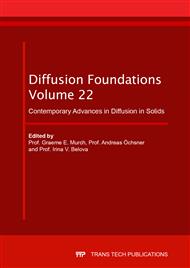p.19
p.24
p.34
p.39
p.48
p.55
p.65
p.74
p.84
Discrete Wavelet Analysis of Electrochemical Current Noise of a High-Alloy Cast Steel in Sulfuric Acid and Sodium Chloride Solution
Abstract:
The electrochemical current noise signal of a high-alloy cast steel was investigated in a 0.1 M sulfuric acid solution and in a 5 wt.% sodium chloride solution. In the sulfuric acid solution, the current time signal reveals characteristic spikes of high amplitudes. In the chloride containing solution, spontaneous power drops with a subsequent recovery of comparatively low intensity characterize the noise signal. Both noise records were analyzed by the discrete wavelet transform. For the noise signal in the sulfuric acid solution, the received wavelet coefficients exhibit the highest values in the fine scale, which signal the dominance of short-time corrosion events that were attributed to the observed hydrogen bubble evolution. In the chloride containing medium, the signal decomposition by the wavelet analysis reveals the highest coefficients predominantly in the coarse scale, indicating a preferred initiation of corrosion processes of high duration. The subsequent observations by scanning electron microscopy, reveal an attack by micro pitting, which is associated with the noise events.
Info:
Periodical:
Pages:
48-54
Citation:
Online since:
May 2019
Authors:
Price:
Сopyright:
© 2019 Trans Tech Publications Ltd. All Rights Reserved
Share:
Citation:


